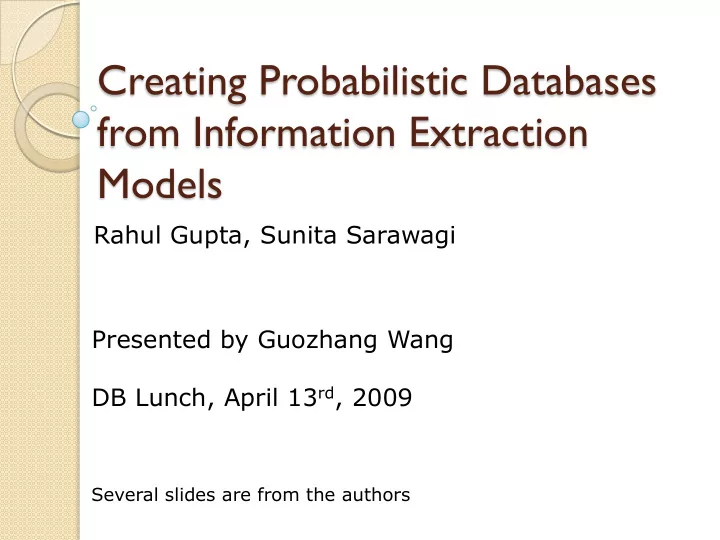

Creating Probabilistic Databases from Information Extraction Models Rahul Gupta, Sunita Sarawagi Presented by Guozhang Wang DB Lunch, April 13 rd , 2009 Several slides are from the authors
Outline Problem background and challenges Proposed Solutions ◦ Segmentation-per-row model ◦ One-row model ◦ Multi-row model Experiments and conclusion
Extracting and Managing Structured Web Data Information Extraction (using CRF, etc): ◦ Text Segmentation (McCallum, UMASS) ◦ Table Extraction (Cafarella, UW) ◦ Preference Collection (Wortman, UPenn) Uncertainty Management: ◦ RDBMS ◦ Prob. RDBMS
Challenges in Presenting Data 52-A GoregaonWest Mumbai 400 062 House_no Area City Pincode Probability 52 GoregaonWest Mumbai 400 062 0.1 52-A Goregaon West Mumbai 400 062 0.2 52-A GoregaonWest Mumbai 400 062 0.5 52 Goregaon West Mumbai 400 062 0.2 Segmentation-per-row model Storage efficiency v.s. query accuracy ◦ Top- 1 v.s. all segmentation for each string
Confidence = Probability of Correctness 1 Fraction correct 0.8 0.6 0.4 0.2 0 0 0.1 0.2 0.3 0.4 0.5 0.6 0.7 0.8 0.9 Probability of top segmentation
Trade-off Between Accuracy and Efficiency I Query Accuracy Only best extraction All extractions with probabilities 0.8 Square Error 0.6 0.4 0.2 0 1 2 3 4 Number of columns in projection query
Trade-off Between Accuracy and Efficiency II Storage Efficiency 0.4 Frequency 0.3 0.2 0.1 0 1 2 3 4-10 11-20 21-30 31-50 51- >200 200 Number of segmentations required to cover 0.9 probability
Goal of This Paper Design data models to achieve good trade-offs between storage efficiency and query accuracy ◦ To achieve query accuracy Approximate the extracted segmentation distribution as similar as possible Similarity metric: KL-Divergence KL(P||Q) = s P(s) log (P(s)/Q(s))
Outline Problem background and challenges Proposed Solutions ◦ Segmentation-per-row model ◦ One-row model ◦ Multi-row model Experiments and conclusion
Proposed Data Models Segmentation-per-row model (Exact) One-row model (Column Independence) Multi-row model (Mixture of the two)
Segmentation-per-row Model HNO AREA CITY PINCODE PROB 52 Bandra West Bombay 400 062 0.1 52-A Bandra West 400 062 0.2 Bombay 52-A Bandra West Bombay 400 062 0.5 52 Bandra West 400 062 0.2 Bombay Exact but impractical. We can have too many segmentations!
One-row Model HNO AREA CITY PINCODE 52 (0.3) Bandra West Bombay (0.6) 400 062 (1.0) (0.6) 52-A (0.7) Bandra (0.4) West Bombay (0.4) Each column has an independent multinomial distribution “ Q y ( t,u )” ◦ E.g. P(52-A, BandraWest, Bombay, 400 062) = 0.7 x 0.6 x 0.6 x 1.0 = 0.252 Simple model, but computed confidences are approximated (even wrong)
Populating One-row Model Min KL(P||Q) = Min KL(P|| y Q y ) = Min y KL(P y ||Q y ) Has a closed form solution Q y ( t,u ) = P( t,u,y ) where P( t,u,y ) is marginal dist’n . Marginal P( t,u,y ) can be computed using forward-backward message passing algorithm:
Forward-Backward Algorithm Marginal 52 Bandra Bombay 400 062 52-A Bandra West West Bombay Bandra West Bombay P(t,u,y) = c u (y) y’ t-1 (y’) Score( t,u,y,y ’ )
Multi-row Model HNO AREA CITY PINCODE Prob 52 (0.167) Bandra Bombay (1.0) 400 062 (1.0) 0.6 West (1.0) 52-A (0.833) 52 (0.5) Bandra West Bombay 400 062 (1.0) 0.4 (1.0) (1.0) 52-A (0.5) Rows with same ID are mutually exclusive with row probability “ π k ” Columns in same row are independent ◦ E.g. P(52-A, BandraWest, Bombay, 400 062) = 0.833 x 1.0 x 1.0 x 1.0 x 0.6 + 0.5 x 0.0 x 0.0 x 1.0 x 0.4 = 0.50
Populating Multi-row Model (fix k) Min KL(P||Q) = Max s KL(P s || k π k Q k s ) We cannot obtain the optimal parameter values in closed form because of the summation within the log However, we can reduce this to a well- known mixture model parameter estimation problem, and solve it using EM algorithm.
Enumeration-based EM Approach Initially guess the parameter values π k and Q k y ( t,u ) E Step: soft assign each segmentation s d to segmentation k M Step: update the parameters with ML values using the above soft assignment Note the E step need to enumerate all segmentations s d
Enumeration-less Approach Observation: ◦ We need to enumerate segmentations at E step since we use soft assignment. Idea: ◦ Use hard assignment instead, so that each s d belongs to exactly one component. We use a decision tree to make the hard assignment (use information gain to split node) Then we can have a closed form solution to the optimization problem Merge mechanism to remove the disjointness limit
Outline Problem background and challenges Proposed Solutions ◦ Segmentation-per-row model ◦ One-row model ◦ Multi-row model Experiments and conclusion
Experiment I Comparing multi-row with SPR
Experiment II Comparing multi-row with one-row
Lessons Learned ? Column Independence might not be suitable in some cases (8% v.s. 25%) Multi-row model has a good illustration of the correlations between columns (but) How to implement this probabilistic model? ◦ One single row in Multi-row model will take more space Are accuracy and space efficiency equally important in this application scenario?
Questions?
Recommend
More recommend